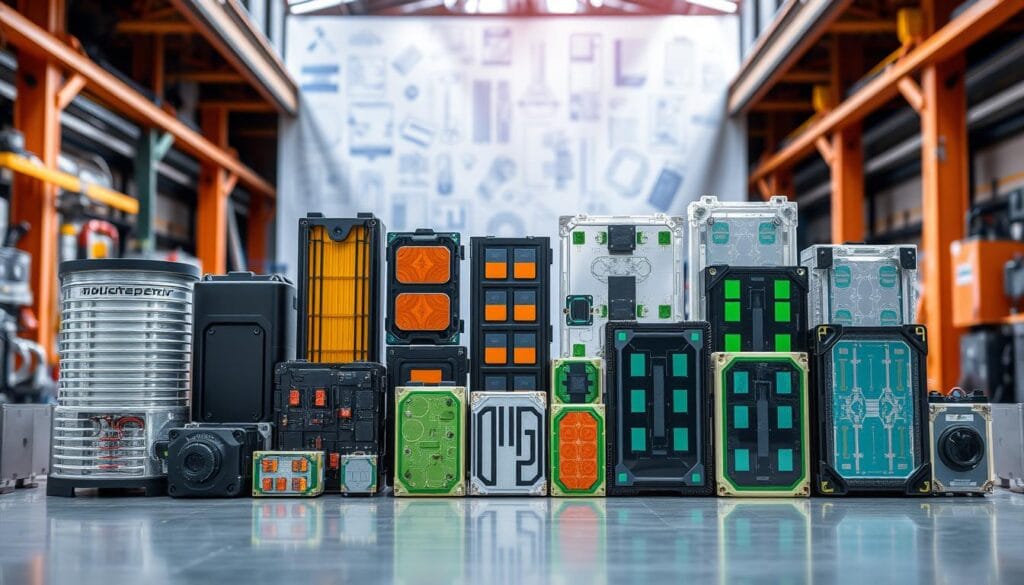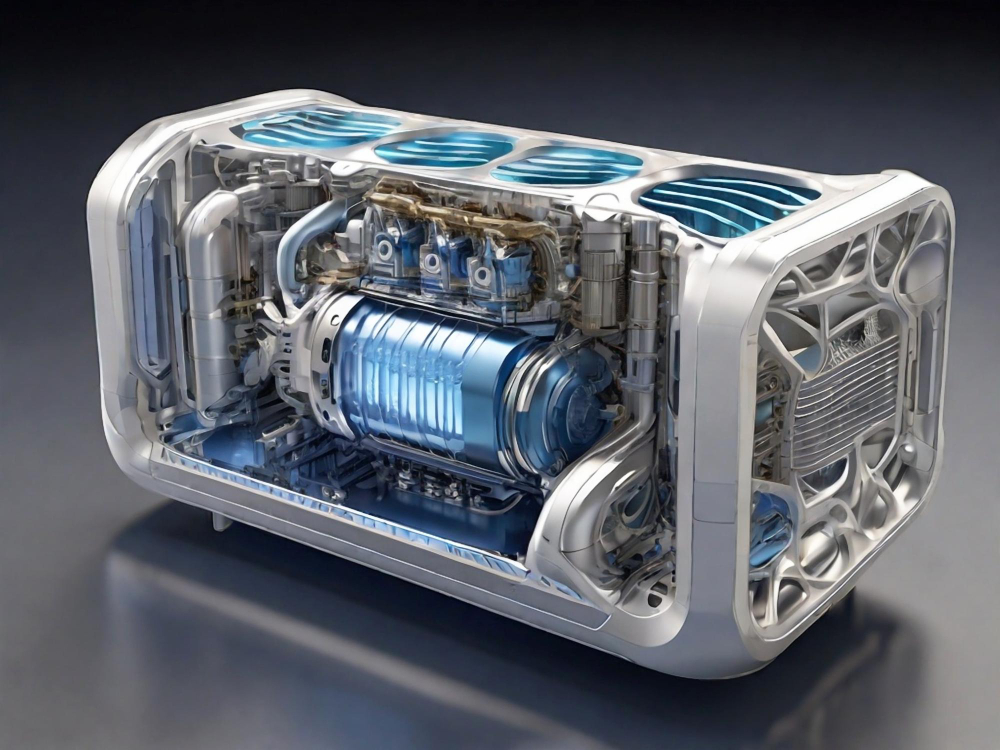The world of electric vehicles (EVs) is changing fast thanks to better battery tech. Now, EV batteries are smaller, pack more energy, and work better. This makes EVs a greener, more sustainable choice for getting around.
Lithium-ion batteries are key in this shift. They’re used in many gadgets like phones and laptops. Most EVs and plug-in hybrids use them to move. Their ability to hold lots of energy and manage heat helps solve range anxiety, making EVs more appealing.
EV battery cells are the basic units that store energy. They come in different shapes like cylinders, pouches, and prisms. These cells are linked up to make modules, which are then put together into a battery pack. The pack is wrapped in a protective case with other important parts like the battery management system and thermal management systems. Electric Car Battery Module
Improvements in battery management and charging systems are making EVs even better. As battery tech keeps getting better, it’s helping us move towards a greener future. It’s a big step towards using less fossil fuel and fighting climate change.
Key Takeaways
- EV battery technology is driving significant advancements in the automotive industry, enabling more efficient, high-performance, and safe electric vehicles.
- Lithium-ion batteries are the most widely used energy storage systems in electric vehicles, offering high energy density and effective thermal management.
- EV battery cells, available in cylindrical, pouch, and prismatic forms, are connected in series or parallel to create battery modules and packs.
- Advanced battery management systems and improved charging infrastructure are enhancing EV performance and practicality.
- The progress in battery technology is contributing to a more sustainable future in transportation, reducing reliance on fossil fuels and combating climate change.
Introduction to Electric Vehicle Battery Modules
Electric vehicle (EV) battery modules are key to a car’s performance and range. They are made of many battery cells connected in series or parallel. This design ensures the right voltage and capacity for the vehicle.
New electric vehicle battery technology has improved a lot. Now, high-voltage batteries offer better energy and faster charging. Lithium-ion batteries are the top choice for EVs because they work well and are getting cheaper.
The process of making a battery pack involves putting together battery modules, cooling systems, and electrical parts. This ensures the battery works well and safely.
Importance of Battery Modules in EVs
Battery modules are the heart of an EV’s battery pack. They affect the car’s range, speed, and overall performance. The quality and design of these modules are crucial for efficient energy storage and use.
This means EVs can go further and charge faster. Well-made battery modules are essential for a good driving experience.
The Nissan Leaf EV contains 48 battery modules interconnected via electrical monitoring equipment, highlighting the importance of well-designed modules in a complete battery pack system.
Key Components of EV Battery Modules
EV battery modules have several important parts. These parts work together to make sure the battery performs well and safely:
- Battery Cells: These are the basic energy storage units, usually lithium-ion. They can be different shapes and sizes, depending on the EV’s needs.
- Electrical Connectors: These connect cells and modules together. They help move energy efficiently and keep an eye on things.
- Thermal Interface Materials (TIMs): TIMs help join battery parts together. They also manage heat, keeping the cells at the right temperature.
- Battery Management System (BMS): The BMS watches over the battery cells. It checks things like voltage, current, and temperature all the time.
- Battery Thermal Management System (BTMS): The BTMS keeps the battery pack’s temperature right. This stops it from getting too hot and keeps it working well.
- Contactor System: This system can cut off the battery’s power in an emergency or if there’s a problem.
- Housing: The housing keeps the modules safe from damage, moisture, and the weather.
- Communications System: This lets all the EV parts talk to each other smoothly and work together.
Designing and putting these parts together makes the EV battery pack efficient, safe, and reliable.
| Battery Module Component | Function |
|---|---|
| Battery Cells | Energy storage units (lithium-ion) |
| Electrical Connectors | Connect cells and modules within the pack |
| Thermal Interface Materials (TIMs) | Join components and provide thermal management |
| Battery Management System (BMS) | Monitor and protect battery cells |
| Battery Thermal Management System (BTMS) | Maintain optimal operating temperatures |
| Contactor System | Emergency disconnection of main battery |
| Housing | Protect modules from environmental factors |
| Communications System | Enable communication between EV components |
Types of EV Battery Module Cells
Electric vehicle battery modules use three main cell types: pouch cells, cylindrical cells, and prismatic cells. Each type has its own benefits and fits different EV needs. The right battery module design is key for safety, thermal control, and performance.
Pouch Cells
Pouch cells are flat and rectangular, wrapped in a flexible aluminum foil. They fit well in custom EVs and are cost-effective. But, they last about 2,000 cycles and can overheat easily. They need good thermal management and monitoring.
Cylindrical Cells
Cylindrical cells, like Tesla’s, are shaped like AA batteries. They pack a lot of energy and cool well. They’re great for long-range EVs, lasting up to 25,000 cycles. But, they’re heavy and hard to pack.
Prismatic Cells
Prismatic cells are flat and used by BMW and Volkswagen. They’re big and pack a lot of energy, making them compact. They’re safe and cost-effective, lasting about 2,000 cycles. They’re perfect for small cars and slim battery needs.
| Cell Type | Shape | Capacity (mAh) | Lifespan (Cycles) | Overheating Risk | Weight | Cost |
|---|---|---|---|---|---|---|
| Pouch | Flat, rectangular | 2,300 – 26,000 | 2,000 | High | Light | High |
| Cylindrical | Cylindrical | 2,300 – 26,000 | 25,000 | Low | Heavy | Low |
| Prismatic | Flat, rectangular, or square | 20,000 – 30,000 | 2,000 | Medium | Medium | Moderate |
Choosing the right cell type depends on the vehicle’s design, needs, and budget. Good battery management and thermal control are vital for all cells. As battery tech improves, EVs will become even more popular and efficient.
Thermal Management in EV Battery Modules
Keeping EV battery modules cool is key to their performance and safety. It ensures they work well, last longer, and don’t overheat. To manage temperature, EVs use liquid, air, and passive cooling methods.
Importance of Thermal Management
Lithium-ion cells, common in EVs, work best between 15°C and 35°C. If they get too hot or cold, they can degrade faster or even catch fire. Keeping them in the right temperature range is vital for their performance and life.
Liquid Cooling Systems
Liquid cooling is the top choice for EVs. It uses a coolant that flows through the battery cells to take away heat. This system keeps the battery pack cool and lets it charge and discharge faster.
| Cooling Medium | Heat Absorption Capacity (Joules/gram/°C) |
|---|---|
| Water | 4.18 |
| Air | 1.005 |
Customized Cold Plates
Cold plates are crucial in liquid cooling systems. They help transfer heat from the battery cells to the coolant. Made from materials like aluminum or copper, they are designed to cool efficiently and evenly.
Good thermal management is essential for battery longevity and performance. It also supports fast charging and high-performance driving. As EV technology advances, better cooling systems will be needed to keep up with faster charging and higher performance.
Insulation and Shielding in EV Battery Modules
Insulation and shielding are key in battery pack design for electric vehicles. They ensure the lithium-ion battery modules work well and stay safe. These steps prevent overheating, reduce fire risks, and protect against damage from shocks and impacts.
Many materials are used for insulation and shielding in EV battery modules. For example, foam encapsulation uses silicone, silicone foam, epoxy, and polyurethane foam. These materials keep the battery cool during fast charging and discharging. This is crucial for the battery’s long life and good performance.
Other advanced materials are also used for insulation and shielding:
- PPG CoraChar SE 4000 is a fire protective coating for battery packs and components.
- Tflex CR607 is a thermal gap filler material with high thermal conductivity for EV batteries and electronics.
- HB Fuller EV Protect 4006 is a flame retardant, low-density polyurethane foam for potting and encapsulating cylindrical cells.
- Formex™ Polypropylene Electrical Insulator Material is durable and flame-retardant, meeting strict safety and environmental standards.
- Kapton® Polyimide Films are flame-resistant and maintain electrical, chemical, and mechanical properties under harsh conditions.
Effective insulation and shielding need precise application techniques. Specialized equipment like Graco PR70 Meter, Mix, and Dispense Systems are used. They ensure the right amount of sealants and adhesives are applied in EV battery module manufacturing.
As electric vehicles become more popular, better insulation and shielding technologies are needed. Advances in thermal management and battery management systems will help. These improvements will make electric vehicle batteries more efficient, reliable, and sustainable. This will help EVs become more widely used in the future.
Environmental Sealing and Protection for EV Battery Modules
Electric vehicles are becoming more popular fast. This means we need EV battery designs that can handle tough weather. Sealing and protecting EV battery modules is key to keeping them safe and working well. Good sealing helps batteries last longer, cuts down on warranty claims, and keeps energy density high while keeping batteries safe.
Importance of Effective Seals and Gaskets
Seals and gaskets protect EV battery modules from water, corrosion, and dirt. They must meet strict standards like IP68. Good sealing stops damage to battery cells and keeps everyone safe in the vehicle.
It also helps keep the battery at the right temperature. This stops problems like thermal runaway, where the battery gets too hot.
Materials Used for Sealing and Protection
The materials for EV battery seals are getting better all the time. They include silicones, polyurethane, and butyls. These materials handle temperature changes, chemicals, and weather well.
New materials help prevent electrical fires in EV batteries. This is thanks to advances in science.
New ways to apply seals, like CIPG and FIPG, are faster and better. Getting the right amount of seal is important. This ensures the seal works well.
Graco provides dispensing solutions tailored for pack seal applications, ensuring reliable and consistent bead application in EV battery modules.
Other materials also help protect EV battery modules. EMI shielding keeps out radio signals and static. Thermal Interface Materials (TIMs) help move heat away from batteries.
Good sealing and protection help make EVs better and cheaper to make. As more people want electric cars, using the latest sealing tech is crucial for success.
Challenges in EV Battery Module Development
The electric vehicle (EV) industry is booming. The International Energy Agency predicts a 36% annual growth in EVs, reaching 245 million by 2030. Manufacturers face big challenges in making efficient and affordable battery modules. They need to cut costs, boost energy density, and speed up charging while keeping batteries safe and lasting long.
Cost Reduction
Lowering costs is a major hurdle in EV battery module development. Battery packs are a big part of an EV’s cost. Finding ways to make them cheaper without losing performance is key. New manufacturing methods, like self-pierce riveting, can save a lot of CO2 and cut costs.
Using smart gap filler systems in EV battery making can also save up to 20% of materials. This helps in reducing costs further.
Improving Energy Density
Boosting energy density is crucial for EVs. Higher density means longer ranges and lighter batteries, making EVs more appealing. Researchers and makers are exploring new cell chemistries and designs to improve energy density.
Simulation technology helps in designing safer and more efficient batteries. It analyzes how batteries work under different conditions. This way, engineers can make EVs go further and be more compact.
Enhancing Charging Speed and Range
Charging speed and range are key for EV buyers. Faster charging without harming battery health is a big challenge. New fast charging tech and better cell chemistry are helping.
But, it’s important to avoid battery damage from fast charging. Good cooling systems and cell balancing are needed. This ensures EVs can charge quickly and travel far, making them more competitive.
Overcoming these challenges needs teamwork between designers, engineers, and makers. Digital tools and simulation can speed up innovation. Virtual testing can cut down development time. Looking into second life for batteries and recycling can also help.
As the EV market grows, solving these problems is vital. It will help make EVs more popular and meet the demand for efficient, reliable, and affordable electric cars. For more on EV challenges, check out this article by Ennovi.
Advancements in EV Battery Module Technology
The electric vehicle (EV) industry is seeing big changes in battery module tech. These changes make EV batteries more efficient, safer, and last longer. They help solve problems like short driving ranges and slow charging.
Researchers and makers are working on new cell designs and materials. This is getting us ready for the next big step in EV battery tech.
Innovative Cell Architectures
One big step is the creation of new cell designs. These designs improve how batteries handle heat and work better overall. Companies like Enovix have changed the battery’s structure to better manage heat.
They put the battery cooling plate on the side. This makes the battery 10 times better at handling heat than old EV cells.
This design also helps the battery expand safely. It lets makers use the best materials, like pure silicon. The whole design makes the battery safer and more efficient.
Material Agnostic Approaches
Another big change is using materials in new ways. This lets makers choose the best materials for each battery. Enovix’s approach lets them use materials beyond just lithium-ion.
This opens up new ways to make batteries better. Makers can try out new chemistries like solid-state electrolytes. This means batteries can charge faster and last longer.
The global demand for EV batteries reached over 750 GWh in 2023, reflecting a 40% increase from 2022. This growth is primarily driven by the increasing adoption of electric vehicles worldwide.
The tech advances in EV batteries are making them cheaper and better. New cell designs and material choices are key. They help EV makers create batteries that are more efficient, reliable, and green for the future.
Electric Car Battery Module Manufacturing Process
The making of electric vehicle battery modules is a detailed and complex process. It starts with creating individual battery cells, which are the core of the battery pack. There are three main types of EV battery cells: cylindrical, prismatic, and pouch cells. Each type has its own features that shape the production process.
The first step is making electrode sheets. These sheets are coated with a paste on metal foils. The paste includes graphite, iron, carbon, and lithium agents. Between these sheets, separator sheets are placed to prevent short circuits. The sheets are then put in cell casings to protect them from the electrolyte.
The next step is stacking the electrode and separator sheets. Different methods are used, like single sheet stacking and winding. Metal strips are then connected to the stacks for electrical conductivity.
After assembly, the cells go through quality tests. Inspection systems check the cells and components early on. The cells are then grouped into modules, a step before the complete battery pack.
The assembly of battery modules and packs involves the application of sealants and adhesives for component bonding. Positive and negative tabs of each cell are connected to a busbar through laser welding to create a complete electrical circuit. Endothermic coatings are applied to cells and modules for fireproof protection and temperature regulation.
Several key factors are considered during the battery module manufacturing process:
- Battery weight reduction and optimization of production processes are crucial due to increasing driving range requirements and the need to minimize charging time.
- A detailed check of the battery tray and correct material calculation ensure proper application of the thermal compound material for managing battery heat.
- The use of multispindle with 3D robot guidance allows for a perfect tightening process during module assembly.
- The application of a 2-component fire protection material delays burn-through in case of battery cell inflammation.
The last step is joining the battery modules to the pack housing. This is a challenging task due to fast cycle times and high complexity. Insulated sockets protect operators from high voltages and prevent short circuits. Flow drill fastening technology, like K-Flow, is used for optimal fastening during cover to tray joining, boosting productivity in battery assembly.
| Battery Cell Type | Characteristics | Manufacturing Process |
|---|---|---|
| Cylindrical Cells | High energy density, good mechanical stability | Winding process, can be automated |
| Prismatic Cells | Efficient packaging, good thermal management | Stacking process, more complex automation |
| Pouch Cells | Lightweight, flexible packaging | Stacking or folding process, manual assembly |
Data-driven services, like those from Atlas Copco, are used throughout the process. They help with usage-based maintenance and process optimization in electric vehicle battery production. This ensures consistent quality, efficiency, and reliability in making battery replacement modules for electric vehicles.
Future of EV Battery Module Technology
The future of electric vehicle (EV) battery module technology is exciting. It aims to boost performance, sustainability, and the driving experience. We’ll see big leaps in battery module design, materials, and how they work.
Improved Performance and Sustainability
Improving EV battery modules is a top priority. The goal is to make them more powerful and eco-friendly. This means longer drives and lighter cars.
Advances in cell balancing and voltage monitoring will also help. They’ll make batteries more efficient and last longer.
Using green materials in battery making is also key. Scientists are looking into recyclable and eco-friendly parts. They want to reduce waste and make batteries last longer.
Enhanced Ownership Experience
Future EV battery modules will make driving electric cars better. They’ll charge faster and work well in all weather. This will make electric cars more fun and easy to use.
These batteries will also need less maintenance and last longer. This will save owners time and money. It will also help the environment.
Broader Adoption of Electric Vehicles
As EV battery module tech gets better, more people will choose electric cars. Better performance, sustainability, and driving experience will make EVs more appealing. This will help bridge the gap between electric and gas cars.
Support from governments and private investors will help too. As battery costs drop and range anxiety fades, more will switch to electric.
| Battery Component | Function |
|---|---|
| Cathode | Determines battery capacity and voltage |
| Anode | Stores and releases lithium ions |
| Separator | Prevents short circuits between electrodes |
| Current Collector | Conducts electric current between electrodes |
| Electrolyte | Enables ion transfer between electrodes |
The future of EV battery module tech is bright. It will change the car world and help our planet. As we keep improving, electric cars will become the norm. This will lead to a cleaner, greener future for all.
Collaboration Between EV Manufacturers and Battery Suppliers
The partnership between electric vehicle (EV) makers and battery suppliers is key to the EV industry’s growth. With the US selling a record 1.2 million EVs in 2023 and China having 20 million EVs by January 2024, these partnerships are crucial. They help meet the rising demand for EVs.
Rimac Technology and EVE Energy are teaming up to make high-voltage battery cells in Europe from 2027. EVE Energy is a top lithium battery maker. Rimac Technology brings its advanced battery tech and engineering skills.
BMW Group and Rimac Technology are also working together on battery tech. This big project aims to make Rimac a major supplier. They have a dedicated space at Rimac Campus for this effort.
Lucid and Aston Martin have a deal worth over $450 million for electric powertrains and batteries. Hyundai Mobis is supplying battery assemblies to Volkswagen AG. These partnerships show how automakers and battery companies are teaming up to speed up EV adoption.
NIO has set up 2,217 battery-swapping stations across six markets by November 2023. They’ve done nearly 33 million battery swaps. CATL and Didi started a joint venture in 2024 to push battery-swapping further. Governments might help these companies work together on this technology.
“The auto industry trend towards electrification has led to an increasing number of automakers joining forces with companies focused on advanced electric powertrains, like Rimac Technology.” – Rimac Group spokesperson
Startups like Ample are also making a big impact in battery tech. Ample has a modular battery-swapping platform for different EVs. Stellantis will use Ample’s tech in 100 Fiat 500e vehicles in Spain in 2024.
As the EV market grows, partnerships will be key to solving challenges like cost and range. Strong partnerships and open communication will help drive innovation and make EVs more common worldwide.
Conclusion
The fast growth of electric car battery modules has boosted electric vehicles. They offer better performance, longer drives, and are more eco-friendly. New tech like advanced cell designs and smart cooling systems make EVs more reliable.
Lithium-ion batteries are top picks for EVs because they pack a lot of energy and last long. But, nickel-metal hydride (NiMH) batteries are cheaper and still good for EVs.
The electric car world is working hard to make EVs more affordable and efficient. It’s key for car makers and battery suppliers to work together. This helps solve problems like high costs and limited range.
Improving battery management systems and building more charging spots are big steps. They help ease worries about running out of power and encourage more people to choose EVs.
The push for greener cars is getting stronger. New battery tech like solid-state batteries is on the horizon. It will make EVs even better for the planet.
Many countries aim to stop using gas cars soon. This means more demand for electric car battery modules. The EV industry is ready to make our roads cleaner and greener.










